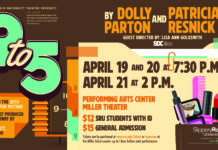When the word “cheerleader” is mentioned, most people think of football games, high school pep rallies, and girls in skirts waving pom-poms in the air, but the SRU male cheerleaders are out to disband what most people view as the stereotypical cheerleader.
Of the 44 SRU cheerleaders and the 18 of those that are on the co-ed team, only five are male. But according to Varsity.com, co-ed teams mean higher baskets and stunts and more extreme tumbling.
In other words, men are necessary to the sport of cheerleading, according to senior sport management major and cheerleader Nick Price.
“We have a much louder dominating voice than females that is able to carry to the beat of the cheers and project farther into the crowd,” Price, 21, said. “Also, we are able to do co-ed stunts that require one male to one female and can look more impressive and eye-catching to the crowd.”
Senior sustainable management major Corey Doyle, 21, began tumbling in eighth grade, which led to his discovery and love of cheerleading throughout high school. Upon graduating, Doyle enrolled in King’s College in Wilkes-Barre, Pa., but did not participate in cheerleading there. When he transferred to SRU, Doyle joined the co-ed cheerleading team.
“It’s taught me everything in my life, I think,” Doyle said. “It’s given me a job. I’ve met so many people. My closest friends are all cheerleaders. It’s a lot of responsibility with money and making sure you know your stuff and knowing what time you have to be at practice and what to do at practice and fundraising.”
Thomas Foley, a post-baccalaureate exercise science major, 26, has been cheering for nine years.
“Before I came to Slippery Rock, I went to Syracuse University,” Foley said. “My freshman year they did something similar to our Weekend of Welcome, and at this pep rally, I saw this guy hold up a girl with one arm, and I thought that was really cool. So I was like, I’m going to do it, and I got into it.”
According to Doyle, the men attend practice twice a week, go to the gym together once a week, and attend games on weekends. A large portion of preparation and practice for cheerleading happens on their “off” time, Price said. Many of the guys visit the gym several times a week, eat healthy, coach at cheerleading gyms or camps, and work cardiovascular exercise in order to remain at their physical peak throughout the season and competitions.
“You have to be personally motivated to do it,” Price said. “Our coach isn’t there to breathe down our back and to tell us everyday this is what we need to do. We have to find motivation within ourselves or within each other.”
Plus, Foley asserted that a lot of cheerleading is speed, coordination, and power, which require extra practice time or time at the gym to maintain.
Throughout December and part of January, the men will begin two-a-day daily practices in preparation for competition.
“Our routine is just two and a half minutes long, so we’re just running that constantly,” said Foley. “Our bodies are taking a beating and just pushing through it. Especially that second practice can be a struggle sometimes. You’re already sore, and you practice two times each day, and the day before that you practice two times, and the day before that, and you just keep going. It kind of takes a toll.”
Many may find it surprising, however, that the intense physical demands of the sport are not the most difficult part of cheerleading.
According to Price, the difficulty lies in the fact that cheerleaders, male or female, face many negative stereotypes on a day-to-day basis, such as the beliefs that cheerleaders are stuck up or believe that they are better than others. Foley and Doyle both said that they have dealt with stereotypes as males in a predominantly female sport.
“A lot of people will automatically assume that I am homosexual because I’m a cheerleader, but that is, I think, the most pervasive stereotype that I’ve encountered,” Foley said. “I just brush them off. I honestly don’t think what other people think about me matters that much. If someone I don’t know wants to think that I’m gay, more power to them. If they want to think I’m dumb, great. I’ll just prove them wrong at some point, so I just let it go, let it roll off my shoulder.”
Doyle, too, has learned to ignore comments and stereotypes. With the Universal Cheerleaders Association College National Competition coming up in January, Doyle, who will be competing, has bigger things to worry about.
“This year is the first year that we’re going small co-ed, which means that there are only four guys that get to compete, compared to my first year when we had eight guys compete in nationals,” he said.
“Now that we’re in a small co-ed division, I feel like we definitely stand a chance, and we should have a good season as well as be able to compete highly with the other teams,” Price said. “We’re just really excited for this season. We’ve had a really close good team so far, and I hope we can carry that over and continue everything to nationals season.”







